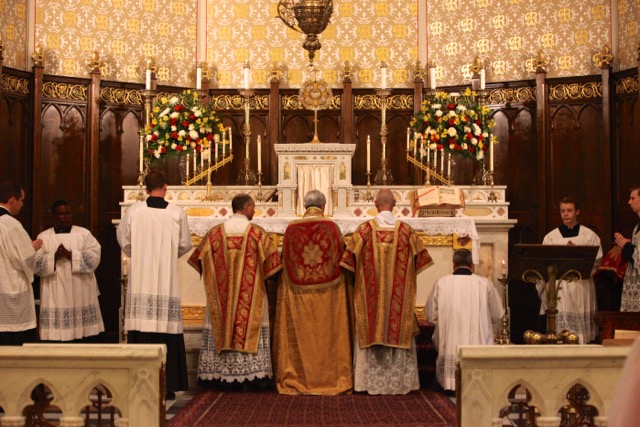 A significant article by Christian Browne that appeared in Crisis Magazine a few days ago. The author addresses the promise and current predicament of the Traditional Mass squarely:
A significant article by Christian Browne that appeared in Crisis Magazine a few days ago. The author addresses the promise and current predicament of the Traditional Mass squarely:
“For, in order for the Traditionalist movement to realize its aims, the “Extraordinary Form” of SP must become less out-of-the-ordinary. While it is true (and wonderful) that the number of places in which the Tridentine Mass is regularly offered has grown markedly since the promulgation of SP, it is a fact that the vast majority of parishes provide Mass-going Catholics with no access or exposure to the ancient rite. The Extraordinary Form remains relegated to specific churches at limited times or to usage on special occasions.”
We should add that, as in the Indult days, in many churches the continuance of these celebrations in the “Extraordinary Form” remains de facto subject to the arbitrary discretion of the pastor. In our area just consider St. John’s (Stamford) or Our Saviour’s (New York).
I do not totally agree with the rather restrictive reading of Summorum Pontificum (“SP”) given by the author. And I can’t agree at all with this historical/sociological analysis:
Thus, SP has created a church within the Church, where the small but fervent band attached the traditional Mass adheres to a different calendar, often hears different readings than those proclaimed at the Novus Ordo and, in general, experiences significantly different liturgical norms and practices.
This “church within a Church” situation is not optimal. It can lead to a kind of separatism among those attached to the old rite who, perhaps unintentionally, come to look down upon the masses at the Novus Ordo parishes where parishioners are subjected to ugly vestments and “Here I am Lord.” Traditionalists can become cut off from the life of their local parishes, too, because they often must travel to specially designated churches on Sundays in order to hear the Tridentine liturgy.
… The divide is rarely noticed, but it is serious, for it is contrary to the very nature of the Church, the first mark of which is its “oneness”—Ecclesia una est.
SP did not create a church within a church, that was created by the Vatican and the Catholic hierarchy by decades of, first, outright persecution of Traditionalists and subsequently by “ghettoizing” them under the Indult regime. Traditionalists may be “looking down” on the Novus Ordo – but their attitude does not compare at all to the contempt they themselves are still widely subject to throughout the establishment Church. And in fact SP has greatly alleviated these animosities on all sides. Finally the author seems to be still a prisoner of his “Roman Catholic” legacy in that he is more concerned about preserving some imaginary monolithic unity within the Church than with upholding the truth and true worship. It’s an attitude under which Eastern Rite Catholics have long suffered.
But we can wholeheartedly agree with the author’s recommendations on the steps which must be taken:
Therefore, building upon the gift of SP, Traditionalism should now seek greater integration of those attached to the traditional Mass into ordinary parish life. The way to do so is obvious, yet fraught: to bring the traditional Mass into the regular practice of as many parishes as possible, particularly on Sundays. Indeed, SP expressly allows “one” celebration of the traditional Mass on a Sunday or feast day in a local church (SP Art. 5, Sec.2).
Now, again, working within the framework erected by SP, this spread of the traditional Mass into the usual roster of masses in a typical parish would have to commence with the laity—the “stable group of Faithful” desirous of such a Mass. In order to encourage the creation of such groups, we should enlist the aid of the many diocesan-level and regional Latin Mass organizations that have already successfully sponsored traditional Masses at designated locations. These groups could solicit interest in, and assist with, the creation of parish-level arms designed to make the request for the traditional Mass mandated by SP.
Mr. Browne thus looks to the evangelical action of the laity as the driving force behind the continued growth of the Traditional Mass. So strangely enough,it is the resistance to the “Mass of the Council” that will realize the alleged conciliar goal of “empowering the laity!” And has it not been the aim of our Society since 2007 to foster the expansion of the celebration of the Traditional Mass to many new churches and parishes?
An article well worth reading!
Related Articles
No user responded in this post